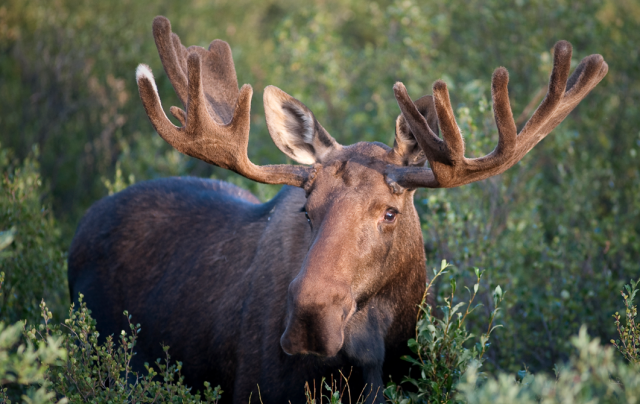Moose, ungulate populations under fire in the Kootenay region
The B.C. government is further reducing the number of moose hunt permits in the province, including a huge drop in the West Kootenay, in order to put the brakes on the decline in moose population.
Limited-entry hunting permits for moose cows and calves have been reduced to 200 for this year, down from 1,792 in 2011.
Although noticeable moose population declines have been reported in other parts of the region, recent surveys have shown stable populations in the Nelson and Castlegar area, said Greg Bethel, public relations officer for the Ministry of Forests, Lands and Natural Resource Operations.
However, according to the 2014 Provincial Ungulate Species Regional Population Estimates and Status released by the province, moose populations are noted as declining in the Kootenay, Cariboo and Omineca regions, representing about half the area of B.C. The nearly 7,000 moose in the Kootenay region are considered stable to in decline.
In response to the province-wide decline, the ministry is increasing funding by $1.2 million to implement recommendations from wildlife consultant Al Gorley’s recently released strategy report on moose populations.
This new funding is in addition to the $750,000 British Columbia is already spending on moose management this year. The new money is earmarked for on-the-ground activities like habitat enhancement and decommissioning unused forest service roads, which can affect moose survival, as well as research activities.
The report stated that declines in moose population correspond with salvage logging of timber affected by mountain pine beetle infestation.
Population inventories are completed every few years and the province has recently initiated a moose winter tick surveillance program and moose tracking app, which lets users upload information on the number, sex and location of moose they encounter in the wild to a province-wide database. The collected data helps monitor moose populations and alert wildlife staff to emerging issues.
Further afield
Ungulate populations in the region are also dropping. Caribou (290), bighorn sheep (2,300), mountain goat (7,900) and mule deer (20,000) are considered in decline.
The population of 24,000 elk are deemed steady, as are the up to 62,000 white-tail deer in the West and East Kootenay.
In British Columbia, biologists estimate the size of most ungulate species through aerial surveys. Aerial estimation of mule deer numbers is challenging, and not currently used by the province in the Kootenays, primarily because of reduced visibility in forested habitats.
“Although there is substantial variation across the Kootenay region, general population trends are stable for elk and white-tailed deer, and stable-to-decreasing for moose and mountain goats,” said Bethel.
Although mule deer have been in decline since 2005, the population appears to be rebounding based on trends in harvest and monitored populations, he added.
Factors affecting ungulate growth are typically complex and not always consistent across populations, Bethel explained.
“Increasing predator populations, including re-colonization of wolves to the Kootenay region, may explain reduced ungulate densities in some locations while changing forests affect elk and mule deer, which thrive in semi-open forest and shrub communities,” he said.
It is common for ungulate populations to fluctuate, especially in systems with diverse predator/prey communities, Bethel pointed out. To respond to concerns about declining wildlife populations, the ministry typically reduces hunting pressure on adult females if hunting seasons are in place.
“Although hunting of males generally has little or no impact on population trends, ministry staff regularly monitor sex ratios and modify hunting seasons as required,” Bethel said. “In some cases, little can be done to reverse declines apart from predator removal.”
Or a cull. Last season was the second year of the five-year wolf removal project in the South Selkirks, with nine wolves removed. The goal was to remove up to 15 wolves, Bethel explained.
Whether it will help the mountain caribou in the long run, the proof will come out when the project is evaluated in four years.
The urban connection
The one area where deer are on the definite rise is in some Kootenay communities.
Urban deer are becoming a common occurrence in communities across southern B.C. and the northwestern U.S., Bethel confirmed.
Communities with populations of urban deer have seen increases in human-wildlife conflict, including vehicle collisions and damage to property, he noted.
“Adult females, usually those with fawns, can show aggressive behaviour towards people and pets,” Bethel said. “During fall, males can also show aggression toward people and pets. Some dogs have been injured or killed by aggressive urban deer.”
As a result, many communities with this problem have created bylaws that prohibit the intentional feeding of deer or wildlife in hopes of reducing population levels and habituation.
Information on the province’s role regarding urban deer management can be found at: https://news.gov.bc.ca/factsheets/factsheet-urban-deer-management-in-bc.
Species at risk
People have until Nov. 30 to provide their ideas for protecting species at risk in B.C.
The environment ministry has set up a dedicated website here to collect suggestions from the public on new ways to improve monitoring, research and stewardship of species.
The website includes information on current efforts to protect the northern spotted owl, northern leopard frog, western rattlesnake and whitebark pine, with new stories posted each week through the six-week engagement period.
Environment Minister Mary Polak said the public input will be used to assess existing protection programs and develop new ones.
You can read read Gorley’s full report here.






















